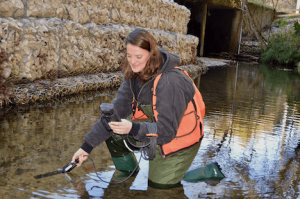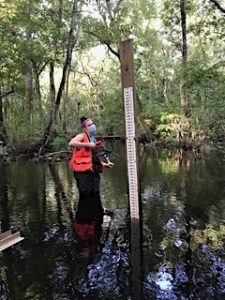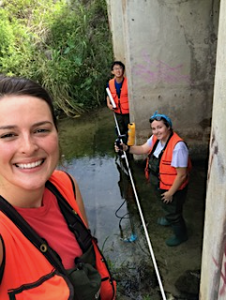“Metabolism and Nutrient Dynamics of Sub-Tropical Urban Streams”
Emily Taylor (Soil & Water Sciences Ph.D. 2023)
Topic

Emily Taylor studies urban streams and how urbanization is impacting ecosystem metabolism and nutrient cycling. Ecosystem metabolism describes the coupled processes of primary production and ecosystem respiration. Primary production is the fixation of inorganic carbon into organic material, resulting in the storage of energy and the creation of oxygen. That stored organic material is the food source for the next step in the food chain. Ecosystem respiration refers to the use of oxygen to break down organic material to generate energy, releasing carbon dioxide as a by-product of that reaction.
Primary production is an important source of energy in aquatic ecosystems while respiration marks the use and transfer of energy through the system. Several factors regulate these processes including light availability, temperature, hydrology, nutrient availability, and the composition of organic material. Urbanization introduces a variety of stressors that influence these regulators of ecosystem metabolism. Ultimately, these stressors affect energy generation, storage, and transference through the ecosystem.
Research Questions
How are humans changing and impacting urban streams’ ecosystem metabolism?
How are nutrients cycling through an urban stream based on that human impact?
“There are definitely certain sources you can point to in an urban environment that impact urban streams,” Emily Taylor said. “Run-off of fertilizer from residential lawns and even little patches of grass on commercial properties is one. Another is human waste products coming from septic systems and leaky sewer lines.”
Yard waste, such as grass clippings and leaves, and animal waste are also contributing to what ecologists call urban stream syndrome. Another factor is the physical properties of the stream. Naturally occurring, they tend to be wide, shallow, and are able to meander. However, a man-made urban stream will narrow and deepen, oftentimes streams will be straightened and lined with a hard surface such as concrete.
“We are good at moving water off of the landscape and out of the way, so it doesn’t impact humans, houses, or roads,” Taylor explained. “So, you just have this large volume of water rushing through the stream. This can lead to large amounts of erosion which can scour the stream bed of important habitat and microorganisms while deepening the banks of the stream channel.”
Research and Early Results

To assess the human impacts on streams, Taylor worked with her advisor, Dr. AJ Reisinger, SWS assistant professor of urban soil and water quality, to identify seven sites in Gainesville for measurements. Those range from a mostly residential neighborhood to a natural conservation area to a heavily commercial section of the city.
“We chose these sites to represent the range of different activities commonly found in urban landscapes,” Reisinger explained. “The range of sites will allow us to identify how a range of urban land uses affect in-stream processes.”
Every other week, Taylor and one of her lab mates visited each site to download data. She collected measurements for nutrients, dissolved organic material, conductivity, turbidity, and pH as well as dissolved oxygen. Dissolved oxygen allows Taylor to indirectly measure the amount of carbon dioxide created or used in an aquatic ecosystem. During the day, many organisms, such as algae, aquatic plants, and cyanobacteria, undergo photosynthesis which uses carbon dioxide and creates oxygen. Throughout the entire day, every organism in the stream is performing respiration, which uses oxygen to create energy and releases carbon dioxide. The sensors will show these changes in concentration at five-minute intervals.
Taylor will have three years of data which will allow her dynamics of the streams across sites but also over seasonal and annual time scales.
“The nutrient data and some of the other parameters I’m collecting, like dissolved organic material, there is a lot of information and so it will help us fine-tune our understanding and see maybe more nuanced changes throughout the year,” she said.
Taylor is learning how to code all the data so she can run various modeling scenarios. Her goal is to do as much of the statistical analysis for the project as she can.
“People before me have learned how to model metabolism in-stream, so I will be using their model for that. The other measurement data I have – I’m taking several stats classes to manage that data,” Taylor said. “I’m excited. I’m enjoying it, but it’s a new challenge for sure.”
Implications

(2019 photo by Emily Taylor)
While Taylor will analyze two-to-three years of information from the streams, the data gathering will continue after she completes her degree. Reisinger hopes to monitor the seven stream sites for decades. The goal is to see how streams in a subtropical environment behave compared to streams elsewhere.
“A lot of research has been done in more temperate climates on urban and non-urban stream metabolism and nutrient cycling, but we have a unique karst topography, so the limestone characteristics present different questions and challenges,” Taylor explained.
The weather pattern is another difference. Many parts of the United States, have snowmelt and significant rainfall in the spring. In Florida, the rainy season is in the middle of the summer, which is when streams elsewhere are most productive.
“Our streams would be most productive too, but we keep having rain come in and scour all of our streams,” she said. “It’s a different climate pattern than what we’re used to understanding.”
“Emily’s research is setting the stage for what I hope to be a study that lasts my entire career,” Reisinger added. “I hope that in 30 years I’ll be able to go out and measure primary production in a stream and be able to say ‘wow, that’s a lot higher than when Emily measured it!’ Emily has done a fantastic job of setting up not only her own dissertation research but establishing a project that will continue well after she graduates.”
 1
1
